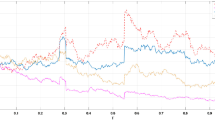Abstract
Asian options are popular financial derivative securities. Unfortunately, no exact pricing formulas exist for their price under continuous-time models. Asian options can also be priced on the lattice, which is a discretized version of the continuous- time model. But only exponential-time algorithms exist if the options are priced on the lattice without approximations. Although efficient approximation methods are available, they lack accuracy guarantees in general. This paper proposes a novel lattice structure for pricing Asian options. The resulting pricing algorithm is exact (i.e., without approximations), converges to the value under the continuous-time model, and runs in subexponential time. This is the first exact, convergent lattice algorithm to break the long-standing exponential-time barrier.
Similar content being viewed by others
References
Abate J. and Whitt W. (1995). Numerical inversion of Laplace transforms of probability distributions. ORSA J. Comput. 7: 36–43
Aingworth, D., Motwani, R., Oldham, J.D.: Accurate approximations for Asian options. In: Proceedings of 11th Annual ACM-SIAM Symposium on Discrete Algorithms (2000)
Barraquand J. and Pudet T. (1996). Pricing of American path-dependent contingent claims. Math. Finance 6: 17–51
Black F. and Scholes M. (1973). The pricing of options and corporate liabilities. J. Polit. Econ. 81: 637–659
Boyle P.P., Broadie M. and Glasserman P. (1997). Monte Carlo methods for security pricing. J. Econ. Dyn. Control 21: 1267–1321
Broadie M. and Glasserman P. (1996). Estimating security price derivatives using simulation. Manag. Sci. 42: 269–285
Broadie M., Glasserman P. and Kou S. (1999). Connecting discrete and continuous path-dependent options. Finance Stoch 3: 55–82
Chalasani P., Jha S., Egriboyun F. and Varikooty A. (1999). A refined binomial lattice for pricing American Asian options. Rev. Deriv. Res. 3: 85–105
Chalasani P., Jha S. and Saias I. (1999). Approximate option pricing. Algorithmica 25: 2–21
Cox J., Ross S. and Rubinstein M. (1979). Option pricing: a simplified approach. J. Financ. Econ. 7: 229–264
Dai T.-S., Huang G.-S. and Lyuu Y.-D. (2005). An efficient convergent lattice algorithm for European Asian options. Appl. Math. Comput. 169: 1458–1471
Dai T.-S. and Lyuu Y.-D. (2002). Efficient, exact algorithms for Asian options with multiresolution lattices. Rev. Deriv. Res. 5: 181–203
Duffie, D.: Dynamic Asset Pricing Theory, 2nd edn. Princeton University Press, Princeton (1996)
Forsyth P.A., Vetzal K.R. and Zvan R. (2002). Convergence of numerical methods for valuing path- dependent options using interpolation. Rev. Deriv. Res. 5: 273–314
Fu M.C., Dilip D.B. and Wang T. (1998/9). Pricing continuous Asian options: a comparison of Monte Carlo and Laplace transform inversion methods. J. Comput. Finance 2: 49–74
Geman H. and Eydeland A. (1995). Domino effect. Risk 8: 65–67
Geman H. and Yor M. (1993). Bessel processes, Asian options and perpetuities. Math. Finance 3: 349–375
Hankerson, D., Menezes, A., Vanstone, S.: Guide to Elliptic Curve Cryptography. Springer, Heidelberg (2004)
Harrison J.M. and Pliska S.R. (1981). Martingales and stochastic integrals in the theory of continuous trading. Stoch. Process. Appl. 11: 215–260
Hull, J.: Options, Futures, and Other Derivatives, 4th edn. Prentice-Hall, Englewood Cliffs (2000)
Hull, J., White, A.: Efficient procedures for valuing European and American path-dependent options. J. Deriv. 1, 21–31 (1993)
Ingersoll, J.E.: Theory of Financial Decision Making. Rowman & Littlefield, Savage (1987)
Kemna A.G.Z. and Vorst A.C.F. (1990). A pricing method based on average asset values. J. Bank. Finance 14: 113–129
Klassen T.R. (2001). Simple, fast and flexible pricing of Asian options. J. Comput. Finance 4: 89–124
Levy E. (1992). Pricing European average rate currency options. J. Int. Money Finance 11: 474–491
Longstaff F.A. and Schwartz E.S. (2001). Valuing American options by simulation: a simple least-squares approach. Rev. Financ. Stud. 14: 113–147
Lyuu, Y.-D.: Financial Engineering and Computation: Principles, Mathematics, Algorithms. Cambridge University Press, Cambridge (2002)
Merton, R.C.: Continuous-Time Finance (revised edn). Blackwell, Cambridge (1994)
Milevsky M.A. and Posner S.E. (1998). Asian options, the sum of lognormals and the reciprocal gamma distribution. J. Financ. Quant. Anal. 33: 409–422
Ohta, K., Sadakane, K., Shioura, A., Tokuyama, T.: A fast, accurate and simple method for pricing European-Asian and saving-Asian options. In: Proceedings of the 10th Annual European Symposium on Algorithms (2002)
Reiner E. and Rubinstein M. (1991). Breaking down the barriers. Risk 4: 28–35
Ritchken P., Sankarasubramanian L. and Vijh A.M. (1993). The valuation of path dependent contracts on the average. Manage. Sci. 39: 1202–1213
Rogers L.C.G. and Shi Z. (1995). The value of an Asian option. J. Appl. Probab. 32: 1077–1088
Shaw, W.T.: Modeling Financial Derivatives with Mathematica. Cambridge University Press, Cambridge (1998)
Turnbull S.M. and Wakeman L.M. (1991). A quick algorithm for pricing European average options. Financ. Quant. Anal. 26: 377–389
Večeř J. (2001). A new PDE approach for pricing arithmetic average Asian options. J. Comput. Finance 4: 105–113
Večeř J. (2002). Unified Asian pricing. Risk 15: 113–116
Zhang J.E. (2001). A semi-analytical method for pricing and hedging continuously sampled arithmetic average rate options. J. Comput. Finance 5: 59–79
Zhang J.E. (2003). Pricing continuously sampled Asian options with perturbation method. J. Futures Mark. 23: 535–560
Zvan R. and Vetzal K. (1999). Discrete Asian barrier options. J. Comput. Finance 3: 41–68
Author information
Authors and Affiliations
Corresponding author
Additional information
An early version of this paper appeared in the Proceedings of the 15th Annual ACM-SIAM Symposium on Discrete Algorithms, 2004.
T.-S. Dai was supported in part by NSC grant 94-2213-E-033-024.
Y.-D. Lyuu was supported in part by NSC grant 94-2213-E-002-088.
Rights and permissions
About this article
Cite this article
Dai, TS., Lyuu, YD. An exact subexponential-time lattice algorithm for Asian options. Acta Informatica 44, 23–39 (2007). https://doi.org/10.1007/s00236-006-0033-9
Received:
Accepted:
Published:
Issue Date:
DOI: https://doi.org/10.1007/s00236-006-0033-9




